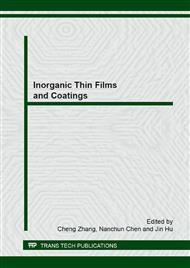[1]
K. Tsukada, M. Sohma, I. Yamaguchi, H. Matsui, T. Kumagai, T. Manabe, Enhanced flux-pinning in fluorine-free MOD YBCO films by chemical doping, J. Physica C 470 (2010) 1449-1451.
DOI: 10.1016/j.physc.2010.05.135
Google Scholar
[2]
B.J. Kim, S.W. Lim, H.J. Kim, G.W. Hong, H.G. Lee, New MOD solution for the preparation of high Jc REBCO superconducting films, J. Physica C 445-448 (2006)582-586.
DOI: 10.1016/j.physc.2006.04.085
Google Scholar
[3]
T. Manabe, W. Kondo, S. Mizuta, T. Kumagai, Preparation of high-Jc Ba2YCu3O7-y films on SrTiO3 (100) substrates by the dipping-pyrolysis process at 750ºC, J. Appl. Phys. 30 (1991) 1641-1643.
DOI: 10.1016/0921-4534(92)90110-x
Google Scholar
[4]
Y. Xu, A. Goyal, K. Leonard, P. Martin, High performance YBCO films by the hybrid of non-fluorine yttrium and copper salts with Ba-TFA, Physica C. 421 (2005) 67-72.
DOI: 10.1016/j.physc.2005.03.001
Google Scholar
[5]
Y. Tokunaga, T. Honjo, T. Izumi, et al., Advanced TFA-MOD process of high critical current YBCO films for coated conductors, Cryogenics. 44 (2004) 817-822.
DOI: 10.1016/j.cryogenics.2004.04.010
Google Scholar
[6]
M.W. Rupich, YBCO coated conductors by an MOD/RABiTS process, IEEE. Trans. Appl. Supercond. 13 (2003) 2458-2461.
Google Scholar
[7]
T. Araki, I. Hirabayashi, T. Niwa, A large volume reduction and calcining profile for large-area YBa2Cu3O7-x film by metalorganic deposition using trifluoroacetates, Supercond. Sci. Technol. 17 (2004) 135-139.
DOI: 10.1088/0953-2048/17/1/023
Google Scholar
[8]
C. Apetrii, H. Schlorb, M. Falter, et al., YBCO thin films prepared by fluorine-free polymer-based chemical solution deposition, IEEE. Trans. Appl. Supercond. 15 (2005) 2642-2644.
DOI: 10.1109/tasc.2005.847756
Google Scholar
[9]
T. Araki, I. Hirabayashi, Review of a chemical approach to YBa2Cu3O7-x -coated superconductors- metalorganic deposition using trifluoroacetates, Supercond. Sci. Technol. 16 (2003) R71–R94.
DOI: 10.1088/0953-2048/16/11/r01
Google Scholar
[10]
T. Puig, J. C. Gonzalez, et al., The influence of growth conditions on the microstructure and critical currents of TFA-MOD YBa2Cu3O7 films, Supercond. Sci. Technol. 18 (2005) 1141–1150.
DOI: 10.1088/0953-2048/18/8/020
Google Scholar
[11]
D. E. Wesolowski, Y. R. Patta, M. J. Cima, Conversion behavior comparison of TFA-MOD and non-fluorine solution-deposited YBCO films, J. Physica C. 409 (2009) 766–773.
DOI: 10.1016/j.physc.2009.04.008
Google Scholar
[12]
Y. Xu, A. Goyal, J. Lian, et al., Preparation of YBCO films on CeO2-Buffered (001) YSZ substrates by a non-fluorine MOD method, J. Am. Ceram. Soc. 87 (2004) 1669–1676.
DOI: 10.1111/j.1551-2916.2004.01669.x
Google Scholar
[13]
Y. Chen, F. Yan, G. Zhao, G. Qu, L. Lei, Fluorine-free sol-gel preparation of YBa2Cu3O7-x superconducting films by a direct annealing process, J. Alloys and Compounds 505 (2010) 640-644.
DOI: 10.1016/j.jallcom.2010.06.098
Google Scholar
[14]
J.W. Lee, Y.S. Joo, S.H. Moon, S.I. Yoo, Fabrication of high-quality epitaxial YBCO films prepared by fluorine-free MOD, J. IEEE Trans. Appl. Supercond, vol. 21, pp.2767-2770, 2011.
DOI: 10.1109/tasc.2010.2093553
Google Scholar
[15]
L. Lei, G.Y. Zhao, J.J. Zhao, H. Xu, Water-vapor-controlled reaction for fabrication of YBCO films by fluorine-free sol-gel process, J. IEEE Trans. Appl. Supercond, vol. 20, pp.2286-2293, 2010.
DOI: 10.1109/tasc.2010.2050589
Google Scholar
[16]
H. Kozuka, M. Kajimura, et al., Crack-free, thick ceramic coating films via non-repetitive dip- coating using polyvinylpyrrolidone as stress-relaxing agent, J. Sol-Gel. Sci. Tech, 19 (2000) 205-209
DOI: 10.1002/chin.200005290
Google Scholar
[17]
J.Z. Chen, Modern Crystal Chemistry, second ed., Higher Education Press, Beijing, 2004.
Google Scholar
[18]
J. C. G. Gonzalez, Coated Conductors and Chemical Solution Growth of YBCO Films: A Micro- Raman Spectroscopy Study, Barcelona, 2005.
Google Scholar


